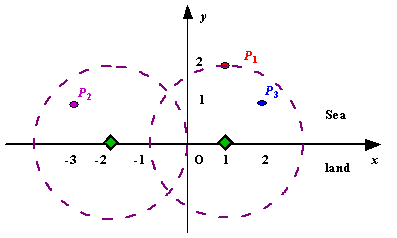Radar Installation
| Time Limit: 1000MS | Memory Limit: 10000K | |
| Total Submissions: 68578 | Accepted: 15368 |
Description
Assume the coasting is an infinite straight line. Land is in one side of coasting, sea in the other. Each small island is a point locating in the sea side. And any radar installation, locating on the coasting, can only cover d distance, so an island in the sea can be covered by a radius installation, if the distance between them is at most d.
We use Cartesian coordinate system, defining the coasting is the x-axis. The sea side is above x-axis, and the land side below. Given the position of each island in the sea, and given the distance of the coverage of the radar installation, your task is to write a program to find the minimal number of radar installations to cover all the islands. Note that the position of an island is represented by its x-y coordinates.

Figure A Sample Input of Radar Installations
We use Cartesian coordinate system, defining the coasting is the x-axis. The sea side is above x-axis, and the land side below. Given the position of each island in the sea, and given the distance of the coverage of the radar installation, your task is to write a program to find the minimal number of radar installations to cover all the islands. Note that the position of an island is represented by its x-y coordinates.

Figure A Sample Input of Radar Installations
Input
The input consists of several test cases. The first line of each case contains two integers n (1<=n<=1000) and d, where n is the number of islands in the sea and d is the distance of coverage of the radar installation. This is followed by n lines each containing two integers representing the coordinate of the position of each island. Then a blank line follows to separate the cases.
The input is terminated by a line containing pair of zeros
The input is terminated by a line containing pair of zeros
Output
For each test case output one line consisting of the test case number followed by the minimal number of radar installations needed. "-1" installation means no solution for that case.
Sample Input
3 2 1 2 -3 1 2 1 1 2 0 2 0 0
Sample Output
Case 1: 2 Case 2: 1
需要判断d<0,a[i].y>d情况。
首先,按照x坐标排序,对于每个岛屿求出雷达所能放置的区间,然后对这些进行处理,x1,x2;
设当前雷达放置位置为nowx,对于下一个区间,如果写x1>nowx,显然多需要一个雷达,反之如果nowx>x1,nowx=min(nowx,x2);
1 #include <iostream> 2 #include <cstdio> 3 #include <algorithm> 4 #include <cstring> 5 #include <cmath> 6 using namespace std; 7 struct node 8 { 9 int x,y; 10 }a[1000+5]; 11 bool cmp(node q,node p) 12 { 13 if(q.x==p.x) 14 return q.y>=p.y; 15 return q.x<p.x; 16 } 17 int main() 18 { 19 int n,d; 20 int i,j; 21 int k=1; 22 freopen("in.txt","r",stdin); 23 while(scanf("%d%d",&n,&d)) 24 { 25 int coun=1; 26 if(n==0&&d==0) 27 break; 28 bool flag=0; 29 for(i=0;i<n;i++) 30 { 31 scanf("%d%d",&a[i].x,&a[i].y); 32 if(a[i].y>d) 33 flag=1; 34 } 35 if(flag||d<=0) 36 { 37 printf("Case %d: -1 ",k++); 38 continue; 39 } 40 sort(a,a+n,cmp); 41 double nowx=sqrt(double(d*d-a[0].y*a[0].y))+a[0].x; 42 double x1,x2,temp; 43 for(i=1;i<n;i++) 44 { 45 temp=sqrt(double(d*d-a[i].y*a[i].y)); 46 x1=a[i].x-temp; 47 x2=a[i].x+temp; 48 if(x1>nowx) 49 { 50 nowx=x2; 51 coun++; 52 } 53 else if(nowx>x2) 54 nowx=x2; 55 } 56 printf("Case %d: %d ",k++,coun); 57 } 58 }